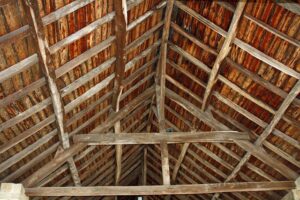Timber Joists: Damage & Prevention
Old beams in properties can wear down over time and sometimes can show signs of overloading with bowing and warping. It is worth regularly inspecting the beams to ensure they are structurally sound and no signs of damage are creeping in. If issues do arise, at least if they are found early you can make the repairs and replacements before they start to spread.
Wet Rot
If an area of timber is exposed to moisture and becomes very damp, different types of fungus may start living off the wood making it weak, soft and spongy. If the timber feels springy when you touch it, then it is best to look in to repairing or replacing the timber.
You can avoid wet rot by ensuring rooms are well ventilated and the roof is fully sealed to prevent any water running in from the outside. Make sure you check all pipes are leak free and the property has no rising damp. Always ensure exposed timber is painted and treated against water as your final line of defence.
Wet rot can often be easily repaired unless the timber is in a structurally important area. The damaged sections can be cut away and replaced with new timber. If the affected area is small, an epoxy resin repair kit would be sufficient and can be used to replace the damaged timber.
Dry Rot
Another fungus-related damage that is even more destructive. The fungus sets in on one damp area and then travels through and over a variety of surfaces to find the next damp area. The fungus can penetrate brickwork and damage all areas of a property along the way.
Look out for dry rot and make sure to stop it before it spreads too far! There are a few ways to identify dry rot. There can be mushroom-like growths on the timber that can even grow through plaster. Additionally, if you spot large cracks or if there are strings across the timber that look like a very dense cobweb, these can also be signs of the spread of dry rot.
If you find dry rot, this will mean the timber will need replacing after a thorough investigation to remove all affected areas and at least one metre around that.
Repair & Prevention
In both cases, investigate the issue fully before jumping at a fix. You need to ensure you need to know how much is damaged and how far it has spread for the most efficient solution.
Find the source of the damp initially. Check your roof has no way for water to get in and that it is set up to keep the attic space well ventilated. If you don’t have them already, perhaps look in to air bricks to improve ventilation and reduce condensation and moisture. Additionally, check the pipes in the area have no leaks and that the chimney has no weaknesses.

We stock a wide range of timber products suitable for all building requirements. Take a look at our product page to see what we have to offer! We also have experts on hand if you need any advice on a project so please feel free to give one of our branches a call.
Don’t miss out! We currently have a special offer on timber joists, fencing and decking. Take a look here at our fantastic deals.